
PRE-MORSE LAND-LINE TELEGRAPH: ( 1830 - 1844 )
Galvani's discovery that electricity could be carried through long wires and give electric shocks to frogs legs at the end of the wires contributed to the development of the "Electric Telegraph". In 1800, a Spaniard named Salva sent signals over a long distance by stationing a slave at the end of the wire to report when he felt the electric shocks. (After reading this, I have always wondered what kind of sounds the man made when he received a "dot" or a "dash"... .OUCH! ...OOOUUUCH!).

British "Needle Telegraph": (1830’s - 1960’s)
In England, Charles Wheatstone developed and patented an electromagnetic telegraph system called a "Needle Telegraph" in which an electrical voltage in a coil of wire pulled a needle left (dot) or right (dash). These early "Needle Telegraph" sets were installed on the English railroad lines in the 1830's and dramatically reduced the number of railroad accidents. They are very attractive and many were still being used in Great Britain well into the 1960’s. [4]
MORSE LAND-LINE TELEGRAPH: ( 1844 - 1881 )( Pre-Triumph Key )
In America, Professor Joseph Henry discovered that an electromagnet consisting of a coil of wire wound around an iron core could attract a metal bar and ring a bell. As early as 1835, he had installed a telegraph system between his office and his home. Samuel Morse found out about Henry's work and began developing his own electric telegraph system which he was able to patent because Professor Henry had not taken out any patents on his early inventions.
Morse’s first key was a simple strip of
springy brass mounted on a wooden base.
He called it the "Correspondent" and
it was similar to the simple "Strap keys" used
later in telegraph and non-telegraph switching.
(See number 138 for an example.)
Keys: ( 1844 - 1881 )

The first key: The Correspondent
The Correspondent had a number of serious problems with its design. Among these was the fact that the springy brass strip was hard to press down, the pressure was uneven, and there was no provision for adjusting the spring tension to suit the needs of the operator. [9]
By the time Morse gave his demonstration of Baltimore-to-Washington telegraphic communication, he had started working with an assistant, Alfred Vail, who was an expert machinist and mechanic. Vail had redesigned the simple "strap key" made from a metal strip, and the wooden framed "register" that Morse had used in his early experiments and eliminated many problems with their operation.
The redesigned key was called the ''LEVER CORRESPONDENT'' and its basic pivoted lever design has been copied in virtually every telegraph key made since that time.

The Lever Correspondent:
This is the original ''Lever Correspondent''. It is on view in the Smithsonian Institution. It has a straight brass lever with a steel pin or ''trunnion'' press-fit into the brass lever which pivots in the upright supports. [10] (Smithsonian Institution.)

Straight Lever Key:
This is an example of an early American telegraph key with a straight lever based on the ''Lever Correspondent'' design. [12]
Camelback Keys:
Vail's straight lever design continued well-into the 1870's in America (and to the present in Europe). American keys with levers with upward humps called ''Camelback'' or ''Humpback'' keys appeared in 1848 perhaps for better appearance.

Very Early Thomas Hall Camelback Key:
This key is typical of the very early Camelback designs of the 1840's and 1850's. The lever shows a very pronounced curve, the contacts are brass-on-brass, and note that there is no spring tension adjusting screw. These early camelbacks are very scarce. [16]

Very Early Camelback Key found in Canada:
This is another example of the very early Camelback design. The lever displays a high, curved arch, the contacts are brass-on-brass, and there is no provision for adjusting the spring tension. Notice that the adjusting screw head is severely bent. In a key that is this rare and old, it would be extremely dangerous and unwise to try to straighten it. Doing so might break the adjusting screw and irrevocably damage the historic value of the key. In 2005, I discovered that this and similar keys were made by Foster in Canada.[18]

Civil War Era Camelback keys:
A smaller upward hump replaced the extreme curves of the earliest camelback levers. The legs attached the keys permanently to the table and made electrical connections to their contacts which were now made of silver. [20]

Phelps Camelback Keys:
George Phelps made "Camelback" keys which were widely used during the Civil War. He was the first inventor to put a spring tension adjustment screw on his keys and this screw has continued to be used to the present time. [30]

Step Lever Keys:
In 1869, the camelback levers were gradually being replaced with step-down levers. These keys are quite rare because relatively few were produced. [34]

Lewis Keys: ( 1874 - ? )
The 1874 "Lewis Patent" was granted on the unique appearance of these keys with their lovely ornate and bulbous base and the sloping lever which set a trend for future levers. [40]
Problems: A Major Flaw in Design.
Keys made before 1881 suffered from one major flaw. As they were used, the steel trunnion pin eventually worked loose from the brass lever allowing the lever to slide left and right and making the key useless. These early keys disappeared after Bunnell invented his "Triumph" key in 1881 (See description in next section). Their scarcity explains why they are valuable.

Submarine Telegraph Cable Keys and Submarine Cables:
The long intercontinental submarine telegraph cables which were laid from the 1850’s-on had very long time-constants due to their great capacitance values. Special cable keys with two sets of contacts, operated by two knobs were used. They put positive voltages on the cable for dots and negative voltages for dashes. This effectively reduced the time-constant and increased transmission rates. [50]
SUBMARINE TELEGRAPH CABLES:

The Tiffany Cables:
Tiffany Co. cut up thousands of unused pieces of the 1858 Transatlantic Submarine Cable and sold them with a certificate of authenticity. So many were made that their value has remained fairly low. [60]

Early Submarine Telegraph Cables Salvaged by W1TP:
Tom Perera - W1TP, using scuba diving gear, recovered several pieces of early submarine telegraph cables that had been under the ocean for well over 100 years: [64] ( See museum: http://w1tp.com for stories, photographs, and descriptions of cables and expeditions.)
REGISTERS: ( 1844 - 1881 )

Very Early Weight-Driven Registers:
The very early registers marked dots and dashes on a paper tape and used weight driven mechanisms to pull the paper tape through. They are very scarce. and expensive. [70]
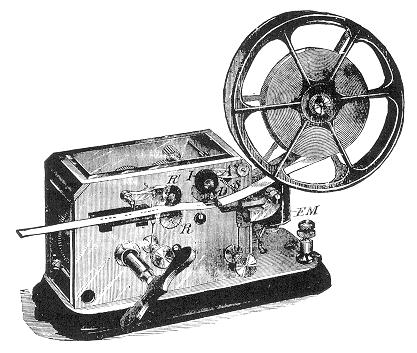
Spring-Driven Registers:
Registers that use spring-wound clockwork mechanisms were made from the 1860's to the 1960's and are much less valuable. [70a] (see number 178.) Many of these wind-up registers were used by fire departments. This further reduces their value to telegraph collectors. The Gamewell Company has been manufacturing fire alarm equipment since before the Civil War and despite its age, their apparatus sells for very low prices [70b] because it is not telegraph equipment.

Sounders: ( 1848 - 1881 )
The lovely "sounders" from this
period can be identified by the fact that most of them use
Horizontally-mounted springs. They sell for much less than
registers or keys because few collectors know how to tell them
from the common post-1881 sounders. Phelps sounders like this
[75]. Others [75a]. They work on 3-6v.
If you want to make a sounder operate, I suggest that you start at 1.5 volts and gradually increase the voltage until you get a reliable pull-in. Do not increase the voltage above this point so as not to heat the coils and risk potential damage to the insulation.

Very Early KOB’s: ( 1844 - 1881 )
Telegraphers soon found a need for portable telegraph sets that could be carried from job to job. They began mounting the sounders on the same wooden base as the telegraph keys making a portable key-and-sounder combination called a "KOB". (Key [with sounder] on Base). [80]

Bunnell Camelback KOB's:
NOTE: Mass produced BUNNELL "practice" versions with cast iron or brass-lever camelback keys are often found. [80a]

Pocket Relays - also called "Pocket Sets" & "Linemen’s Test Sets": ( 1844 - 1881 )
Tiny pocket-sized key-and-sounder combinations called "Pocket Sets" or "Pocket Relays" and used by linemen and Civil War spies are very rare and hard to find. They are often found in oval hard-rubber cases.(shown) [90]

Relays: ( 1844 - 1881 )
Relays from this period have intricate brass parts and large horizontal coils. They sell for quite low prices because collectors are not as interested in them, and because it is hard to identify the really early ones. [95]
POST "TRIUMPH KEY" LAND-LINE TELEGRAPH: ( 1881 - 1950 )
Keys: ( 1881 - 1950’s )
When Jesse Bunnell patented his new solid-steel lever key in 1881, he called it the "Triumph Key" because he believed (correctly) that it would "triumph" over other key designs and make them obsolete. No longer would keys stop functioning because the brass key lever had come loose from the trunnion shaft and started sliding sideways.

The "Leg" Triumph Style Key was designed to be screwed permanently through the operating table. The electrical connections were made under the table to the legs. These keys were made by the tens of thousands from 1881 through the 1950's. These "Leg" style keys are quite common. [102]
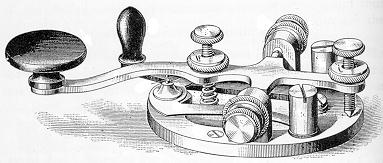
The "Legless" Style Triumph Key was designed to be screwed down to the top of a table. The electrical connections are made to terminal posts on top of the key. They were made by the hundreds of thousands from 1881 through the 1950's and consequently, these attractive keys are VERY VERY common. [104]
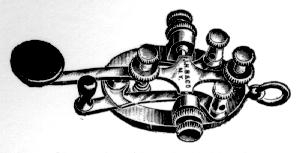
The Miniature Bunnell Triumph Keys and Sounders:
The tiny Bunnell Miniature Triumph Key is one of the most attractive and difficult keys to find. It is a fully functional key that measures only 1.5 inches long. It was made in three versions, the plain key, [108] the key with a ring (shown), [108a] and the key with a pin, [108b].

A tiny sounder was sold by itself [108c]
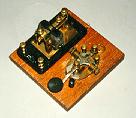
...and as a KOB on a tiny base along with the key. [108d] Most of them were given as retirement presents to telegraph operators, and some were used as jewelry. Consequently, there is always the hope of finding one in a box of estate jewelry. Joe Jacobs, who now owns the Bunnell Company makes a nice new Gold-plated KOB version. [108e] (See Bibliography.)
TRIUMPH KEY LOOK-ALIKE ALERT !:

A VERY inexpensive Japanese key that looks like a Triumph Key but has BALL-BEARINGS and the word Japan under its hollow, cast, imitation brass base is easily mistaken for the "Real" Triumph Keys. These keys were and are sold by the tens of thousands. VERY VERY common! [110]
Competition: During the course of Bunnell's 1881 patent on the solid steel lever "Triumph Key", other manufacturers attempted to develop designs for solid-lever keys that would not impinge on Bunnell's patent.

Victor Keys: ( 1883 - )
The "Victor Key" used the 1883 Hamilton patent design which described an unique knife-edge pivot. They were made in "leg" and "legless" designs and sold by Tillotson and later Greeley and Bunnell. They are fairly scarce. [116]

Steiner Keys: ( 1886 - )
The interesting "Steiner Key" design of 1886 eliminated the use of a trunnion and pivot by using a springy strip of steel as the flexing mounting for the lever. Manufactured by Western Electric, they are hard to adjust and were not popular. They are fairly scarce. [118]

Polechanger Keys: ( 1880’s - 1950’s )
The development of duplex and quadruplex circuits led to the need for keys that could switch positive or negative voltage polarities into a line. The Spies "Polechanger Key" incorporates a three position switch that selects the polarity for a particular line. The switch and the name allow it to be easily distinguished from the military keys of WW-I and WW-II. Common. [120]
NOTE: Many Triumph-Style keys from this period carry the designer's or maker's names. However, Many just carry the names of the companies for which they were made, such as Western Union, and various local telegraph companies and railroads. Some of the company names were stamped onto the bases or shorting levers of keys by the company after special unlabeled keys were purchased from Bunnell or other makers. [122]
Other Manufacturers’ Keys: ( 1881 - 1950’s)
After Bunnell's "Triumph Key" patent expired, many other companies copied the design and put their names on the keys. Menominee Electric Co. (which became Signal Electric Co.), MESCO (Manhattan Electric Supply Co.), Speed-X, and E. F. Johnson are all names you may find on these keys. They are VERY common. [122]

Foreign Keys: ( 1880’s - 1950’s )
Most of the land-line telegraph keys used in Europe and other countries outside the United States have heavy, straight brass levers, heavy brass supports, and pull-down or tension springs. They are quite common in Europe but they are hard to find in this country. [130]

German Camelback Keys: ( 1880’s +/-)
Some few very lovely early curved camelback lever keys were made in Germany. [130a]
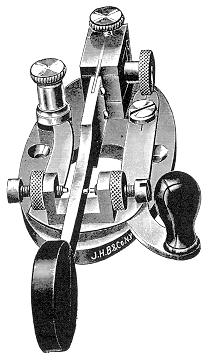
The Bunnell "Sideswiper": ( 1888? - 1950’s )
As telegraphers began to work longer and longer hours sending fast code with up and down movements of their telegraph keys, many began experiencing severe pains in their wrists which they called "Telegrapher’s Paralysis", or "Glass Arm". (We now call it Carpal Tunnel Syndrome.) In 1888 Jesse Bunnell invented a key that used a side-to-side movement and named it a "Sideswiper" or "Double-Speed key". It virtually eliminated "Telegrapher’s Paralysis", and became quite popular all the way into the 1950s. Historian John Casale-W2NI has presented convincing evidence that this key was acutally invented and patented after 1900. [134]

The "Twentieth Century Key" or Pump Handle Key": ( 1900 - )
Foote-Pierson produced another "solution" to Telegrapher’s Paralysis in the form of a lovely key with flowers on its base and a pump-handle-like wooden handle which was moved to the left to make both dots and dashes. They only made about 1000 of these keys and they are very hard to find. [136]

Strap Keys:
Simple "strap keys" from this period are very common. Because they were used for many switching functions in addition to telegraph, they generally sell for very little. [138]

Western Electric Miniature Test Set Key: (Often Mistaken for a "Spy Key") (1900 - )
These tiny keys look as though they belong on a clandestine radio transmitter designed for use behind enemy lines. They are often called "Spy Keys" by sellers hoping to get the maximum amount of money for them. In fact, they do make very nice miniature keys when mounted on a small QRP transmitter. [139]
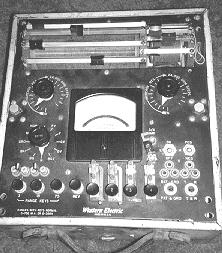
Actually these keys were mounted in sets of four on top of the Western Electric Test Set shown at right. [139a] Each key has a number from 1 - 4 to help the operator identify the correct circuit. Since the test sets are not useful to modern operators, most have had their keys removed and then found their way to the scrap yard.

Sounders: ( 1881 - 1950’s )
Sounders made after about 1881 can be identified by the fact that they use a VERTICAL Spring to position the armature. Both small sounders and the large, sensitive, "Mainline" sounders are VERY common. [140] The less attractive and more recent aluminum armature sounders bring less. Most work on 3-6 Volts. If you want to make a sounder work, I suggest that you start with 1.5 volts and gradually increase the voltage until you get reliable pull-in and stop at this point so that you will not overheat the coils or endanger the insulation with higher voltages.

Sounders in "Resonators" and The "Prince Albert Tobacco Can".
Busy Telegraph Offices and Railroad Stations were very noisy and a wooden "solid state" amplifier box was invented to make the clicks from sounders louder and easier to hear. This triangular or rounded wooden "amplifier" was called a "Resonator". It was mounted on a black metal pedestal [142]

or an articulated swinging arm that could be brought near the operator’s ear. [142a] To allow a telegrapher to be able to distinguish his/her sounder’s clicks from other nearby sounders, a Prince Albert Tobacco can was tucked between the sounder and the wooden box. Opening or closing the lid of the tobacco can changed the tone of the sounder and made it’s sound distinct from the other nearby sounders.

KOB’s: ( 1881 - 1950’s )
Key-and-sounder combination sets (KOB's) from this period are VERY COMMON. [150] Slightly higher prices are usually paid for sets with pretty oval BRASS-based keys and brass armature sounders. Slightly lower prices for sets with oval, black painted cast IRON or steel-based keys and/or sounders with the more recent aluminum armatures.
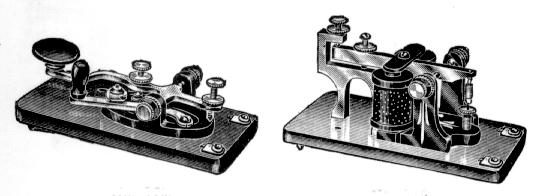
KOB components on separate bases:
The keys and sounders were also sold separately. [152a] [152b]
PRACTICE SETS: ( Combined into the Land-Line Telegraph Section )

BEEKO KOB Practice Sets:
Bunnell made a line of inexpensive KOB practice sets consisting of keys and sounders with black-painted sheet metal key and sounder supports. They were so simply-made, that many were thrown away as junk and they are now somewhat hard to find. [154]

BEEKO KOB Components on separate bases:
The inexpensive BEEKO sheet-metal keys and sounders were also sold separately. [156a] [156b]

Bunnell Non-Electric Key and Sounder Practice Sets:
Several kinds of non-electric key-sounder combinations were made and used for teaching and learning the Morse Code. They produced clicking sounds when the key was pressed. This one uses a mechanical lever connection between the key and the sounder. [160]

This Bunnell Non-Electric Practice Set has the key knob directly attached to the sounder armature. It is cast as part of the armature and extends off to the side. [162]

Box Type KOB’S:
These lovely KOB’s enclosed large and sensitive coils within a wooden box. Even the weak voltages from long telegraph lines would activate the coils and pull the armature to make a clicking sound which was enhanced by striking a piece of metal attached to the wood of the box. [164].
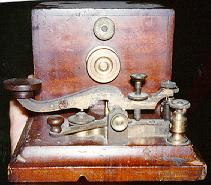
A few early examples of this BOX TYPE KOB design have been seen with camelback and other early keys indicating that some were made in the 1850-1881 period. [164a]

Barclay Box "Snare Drum": KOB:
Similar to above but with exposed coils and a thin wood "Snare Drum" sounding board. Keys were usually "Triumph" style with steel levers.[166]

Pocket Relays - (Also Called "Linemen’s Test Sets"): ( 1881 - 1950’s )
Like the Civil War-era pocket sets, these instruments combine a key and a very sensitive sounder into a pocket-sized instrument that could be easily carried up a telegraph pole to allow a lineman to tap into and test the telegraph wires. [170]

Relays: ( 1881 - 1950’s )
Relays from this period are called "Pony Relays". They have an unique curved upper contact support that looks a bit like the neck of a goose and therefore they are also called "Goose Neck Relays". Hundreds of thousands were made by Bunnell, MESCO, Western Electric, and many other manufacturers, so they are VERY common. [174]

Duplex, Quadruplex, and Repeating Relays: ( 1881 - 1950’s )
Dozens of different schemes to allow several telegraph messages to be transmitted and received simultaneously on a single circuit were developed. Each scheme required a complex relay with intricate and interacting contacts. Since very few people now understand these elegant circuits, their value remains low. [176]

Registers: ( 1881 - 1950’s )
Wind-up registers from this period were made by Bunnell, Tillotson, and Foote-Pierson. Many were used in fire alarm systems to record the fire alarm signals in ink on permanent paper tape. Since many were not used in telegraph systems, they sell for low prices. [178] Gamewell and Roland made registers that were used only for fire alarm systems and have very little value to telegraph collectors. [178a] They also made telegraph-like keys and relays which have very little value to telegraph collectors.

Code Practice Sets: ( 1880’s - 1950’s )
Many of the less elaborate KOB sets discussed above were also used for teaching and practicing sending and receiving the code. The most frequently used practice sets were the BEEKO models which were inexpensive to produce and purchase. As wireless and then radio telegraph communication became popular, Key and sounder practice sets were replaced with Key and buzzer practice sets: [190]
Toy Code Practice Sets:
In the first half of the Twentieth Century inexpensive telegraph sets were very popular toys. They were instrumental in starting many young people on the road to lifetime careers in telegraph.

Young people were fascinated by the ability to communicate over a set of wires. Toy companies, realizing the huge market for these sets, produced tens of thousands of very attractive toy practice sets with keys, buzzers, and lights. Names on the sets include: Western Union, (Right)[192] and Fleron, (Below)[192a] and many others. Although they were very significant, so many thousands were made that they have never become very valuable.
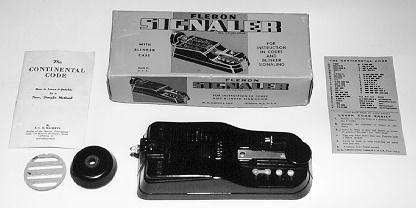
Automatic Code-Sending Practice Devices:

The Omnigraph:
A number of ingenious devices have been invented to help people learn and practice copying the code. One of the first of these was the Omnigraph. It used one or more aluminum disks with the code characters cut as notches in their outer rim. As the disk(s) rotated, the notches opened and closed an electrical contact which could be used to operate a sounder or buzzer. Omnigraphs were available in several models from simple 1 disk hand-cranked versions to 10 and 15 disk spring-driven models which automatically switched between disks. [194] The Natrometer and Teleplex are very similar spring driven code wheel practice devices. [194a]

The Instructograph:
The Instructograph was another device which was very widely used for code practice. It used a paper tape with holes punched into it which allowed electrical contacts to be closed and opened automatically. The contacts then activated a sounder used for land-line Morse Code training. Later models used a buzzer or built-in oscillator which produced a tone. These models were used to train radiotelegraph operators. Several versions were available from hand-wound spring motor versions with battery-powered oscillators to 110V models. They are VERY common and were in production as late as 1983. [198]